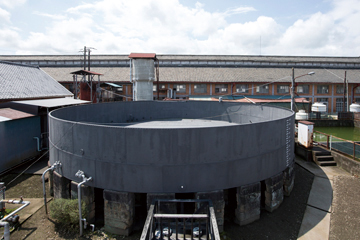2019 METAL CULTURE Yokosuka
Yokosuka Works
Value One Spring 2019 No.64
-

- A steam hammer preserved
at the Verny Commemorative Museum
The Dockyard That Drove Japan’s Modernization
The Yokosuka Iron Works was the largest construction project in the final years of the Edo Period (1603–1868), and powered the modernization of Japan. Built 150 years ago, it incorporated a dockyard that now serves as part of a U.S. Navy base.
Admiral Perry came to Japan in 1853 and forced the Edo Shogunate to open the country to the outside world. This revealed the nation’s relative lack of strength compared to other countries, so the shogunate hastily began to build up its military. The shogunate planned the construction of a modern dockyard to build warships, and put Commissioner of Finance Oguri Tadamasa (who was also the assistant governor of Kozuke Province, equivalent to present-day Gunma Prefecture) in charge of the project.
- Oguri was a member of an 1860 delegation the shogunate sent to the United States. He was astonished by the high level of steelworks and metalworking technology at the Washington Navy Yard, and reportedly took a screw back with him. Upon his return, he was ordered to construct the dockyard. He sought help from the United States, but that country was embroiled in the American Civil War, so he enlisted the cooperation of France instead. French engineer Léonce Verny visited Japan and helped choose the Port of Yokosuka for the site due to its deep waters.
-
-

- Dry Dock 1 is still in use as part
of the U.S. Navy base in Yokosuka
-
In 1865, the shogunate gave the dockyard the name Yokosuka Iron Works, since it would be used to process iron. In 1871, construction was completed on Dry Dock 1. Before World War II, six docks had been built. “Ogura and the other officials at the time were very good at what they did,” says Yokosuka City Museum Curator Katsuhiro Kikuchi with admiration. “Rather than leaving the construction of the dockyard up to France, they went to Europe themselves and procured the necessary equipment and human resources, employing several different languages. What they did was much like the job of an employee at a modern trading company.” A steam hammer imported at that time has been preserved at the Verny Commemorative Museum.
The Yokosuka Iron Works was known for its shipbuilding technology as well as its human resource development, and had a major impact on Japanese engineering research. It also served as an integrated mill, and manufactured things like the Kannonzaki Lighthouse, Japan’s first Western-style lighthouse, and mining equipment for the Ikuno Silver Mine. It achieved a world-class level of technology, such as manufacturing things like the aircraft carrier Shinano in 1940, the largest such craft in the world at the time. The Yokosuka Iron Works laid the foundation for Japan’s development as a technological powerhouse, and was the starting point for manufacturing that continues to this day.






